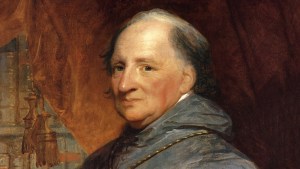George Washington’s religious life has invited considerable speculation over the years. Though he was a member of the Anglican Communion, there has been debate as to whether he was more of a deist than a true adherent to any particular denomination. Part of the reason for this viewpoint was that Washington’s letters tended to avoid mention of Jesus and instead invoked “Grand Architect” and “Providence” — terms generally aligned more with deists than with any organized religion.
A separate viewpoint comes from historian Benson J. Lossing, who said of Washington: “He was a liberal-minded Christian, and regarded all faithful men as the one body, ‘or Church of Christ on earth,’ irrespective of creeds.”
Whatever his true religious convictions were, Washington — who donated his own money to build a Catholic church in Baltimore — certainly seemed more amicable toward Catholics than were most Americans of his era.
It is true that in the 1750s Washington took an anti-Catholic oath. However, this type of oath was a requirement for anyone who wished to hold a position in the colonial government.
When, in June 1775, he assumed the role of commander of the Continental Army, he no longer had to take such oaths. And during his tenure as general, he attended many different types of religious services.
He also banned the celebration of Guy Fawkes Night, on which it was customary for revelers to burn effigies of the pope.
Considering that there were Catholics among the Revolutionaries, along with the vital Catholic ally of France, Washington stated:
“At such a juncture, and in such circumstances, to be insulting their religion is so monstrous as not to be suffered or excused.”
The outcome of the Revolutionary War was in particular a victory for American Catholics, who could now further distance themselves from a former colonial master that had been hostile toward the Catholic Church. Writing in 1900 for The American Catholic Historical Researches, Martin I. J. Griffin said of the Revolutionary War, “It closed with the emancipation of the Catholics of America from the vicious laws in force against them.”
Upon becoming the first U.S. president in 1789, Washington hoped that his fledgling nation could avoid the “horrors of spiritual tyranny.” And he firmly believed that all people should “be protected in worshiping the Deity according to the dictates of [their] own conscience.”
As president, he wrote of his hope that America would successfully avoid “religious disputes carried to such a pitch as to endanger the peace of Society.”
Note from the bishop
In March 1790, Bishop John Carroll (the first U.S. Catholic bishop) wrote to Washington on behalf of American Catholics: “Your exalted maxims and unwearied attention to the moral and physical improvement of our country have produced already the happiest effects.”
Washington wrote a letter to America’s Catholics, expressing his hope that all Americans would remember the Catholic contribution to independence.
After his presidency ended on March 4, 1797, Washington retired to his estate in Mount Vernon, Virginia. He died after a sudden illness on December 14, 1799, at age 67.
The exact cause and circumstances of his death have been a matter of ongoing conjecture and debate. One account claims that, while on his deathbed, he was baptized into the Catholic faith by a Jesuit priest.
There is no conclusive evidence supporting this account, however. And The American Catholic Historical Researches has described such a scenario as “improbable.”
It is possible, though, that a Catholic priest visited a dying Washington simply to offer solace instead of religious conversion.
In any event, it is doubtful Washington died a Catholic. But he seems to have been a true friend of the Church in an era when American Catholics needed a friend in power.



